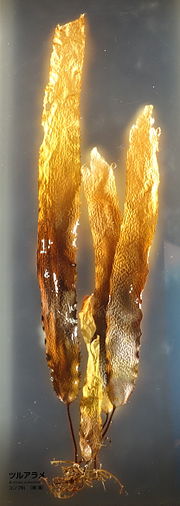Ecklonia stolonifera (Japanese: ツルアラメ, turuarame) is a brown alga species in the genus Ecklonia found in the Sea of Japan. It is an edible species traditionally eaten in Japan.[1]
| Ecklonia stolonifera | |
|---|---|

| |
| Ecklonia stolonifera | |
| Scientific classification | |
| Domain: | Eukaryota |
| Clade: | Diaphoretickes |
| Clade: | SAR |
| Clade: | Stramenopiles |
| Phylum: | Gyrista |
| Subphylum: | Ochrophytina |
| Class: | Phaeophyceae |
| Order: | Laminariales |
| Family: | Lessoniaceae |
| Genus: | Ecklonia |
| Species: | E. stolonifera
|
| Binomial name | |
| Ecklonia stolonifera Okamura, 1913
| |
Chemistry
editPhlorotannins
editEcklonia stolonifera contains the phlorotannins phlorofucofuroeckol A,[2] eckol, dieckol,[3] dioxinodehydroeckol[4] (eckstolonol),[5] 2-phloroeckol, phlorofucofuroeckol B, 6,6'-bieckol,[6] triphlorethol-A,[7] phloroglucinol and 7-phloroeckol.[8]
Those phlorotannins are responsible for the potent pharmacological effects associated with this seaweed.[9] These molecules show a hepatoprotective activity.[6][10]
Oxylipins
editThe oxylipins ecklonialactones A, B,[11] C, D, E and F[12] and fucosterol[7] can also be isolated from the species.
References
edit- ^ Kuda, Takashi; Kunii, Taeko; Goto, Hideyuki; Suzuki, Takamoto; Yano, Toshihiro (2007). "Varieties of antioxidant and antibacterial properties of Ecklonia stolonifera and Ecklonia kurome products harvested and processed in the Noto peninsula, Japan". Food Chemistry. 103 (3): 900. doi:10.1016/j.foodchem.2006.09.042.
- ^ Kim, AR; Lee, MS; Shin, TS; Hua, H; Jang, BC; Choi, JS; Byun, DS; Utsuki, T; Ingram, D; Kim, HR (2011). "Phlorofucofuroeckol a inhibits the LPS-stimulated iNOS and COX-2 expressions in macrophages via inhibition of NF-κB, Akt, and p38 MAPK". Toxicology in Vitro. 25 (8): 1789–95. doi:10.1016/j.tiv.2011.09.012. PMID 21963823.
- ^ Goo, HR; Choi, JS; Na, DH (2010). "Quantitative determination of major phlorotannins in Ecklonia stolonifera". Archives of Pharmacal Research. 33 (4): 539–44. doi:10.1007/s12272-010-0407-y. PMID 20422362. S2CID 26981463.
- ^ Shim, SY; Choi, JS; Byun, DS (2009). "Inhibitory effects of phloroglucinol derivatives isolated from Ecklonia stolonifera on Fc(epsilon)RI expression". Bioorganic & Medicinal Chemistry. 17 (13): 4734–9. doi:10.1016/j.bmc.2009.04.050. PMID 19443227.
- ^ Kang, HS; Chung, HY; Jung, JH; Son, BW; Choi, JS (2003). "A new phlorotannin from the brown alga Ecklonia stolonifera". Chemical & Pharmaceutical Bulletin. 51 (8): 1012–4. doi:10.1248/cpb.51.1012. PMID 12913249.
- ^ a b Lee, Min-Sup; Shin, Taisun; Utsuki, Tadanobu; Choi, Jae-Sue; Byun, Dae-Seok; Kim, Hyeung-Rak (2012). "Isolation and Identification of Phlorotannins from Ecklonia stolonifera with Antioxidant and Hepatoprotective Properties in Tacrine-Treated HepG2 Cells". Journal of Agricultural and Food Chemistry. 60 (21): 5340–9. doi:10.1021/jf300157w. PMID 22587607.
- ^ a b Jung, Hyun Ah; Hyun, Sook Kyung; Kim, Hyeung Rak; Choi, Jae Sue (2006). "Angiotensin-converting enzyme I inhibitory activity of phlorotannins from Ecklonia stolonifera". Fisheries Science. 72 (6): 1292. doi:10.1111/j.1444-2906.2006.01288.x. S2CID 42869137.
- ^ Yoon, Na Y; Chung, Hae Y; Kim, Hyeung R; Choi, Jae S (2008). "Acetyl- and butyrylcholinesterase inhibitory activities of sterols and phlorotannins from Ecklonia stolonifera". Fisheries Science. 74: 200–207. doi:10.1111/j.1444-2906.2007.01511.x. S2CID 24337383.
- ^ Goo, Hyun Ryul; Choi, Jae Sue; Na, Dong Hee (2010). "Quantitative determination of major phlorotannins in Ecklonia stolonifera". Archives of Pharmacal Research. 33 (4): 539–44. doi:10.1007/s12272-010-0407-y. PMID 20422362. S2CID 26981463.
- ^ Kim, Youn Chul; An, Ren Bo; Yoon, Na Young; Nam, Taek Jeong; Choi, Jae Sue (2005). "Hepatoprotective constituents of the edible brown algaEcklonia stolonifera on tacrine-induced cytotoxicity in hep G2 cells". Archives of Pharmacal Research. 28 (12): 1376–80. doi:10.1007/BF02977904. PMID 16392671. S2CID 25793794.
- ^ Todd, James S.; Proteau, Philip J.; Gerwick, William H. (1994). "The Absolute Configuration of Ecklonialactones A, B, and E, Novel Oxylipins from Brown Algae of the Genera Ecklonia and Egregia". Journal of Natural Products. 57 (1): 171–4. doi:10.1021/np50103a028. PMID 8158161.
- ^ Kurata, Kazuya; Taniguchi, Kazuya; Shiraishi, Kazunari; Suzuki, Minoru (1993). "Ecklonialactones-C-F from the brown alga Ecklonia stolonifera". Phytochemistry. 33: 155–159. doi:10.1016/0031-9422(93)85413-L.
External links
editWikimedia Commons has media related to Ecklonia stolonifera.